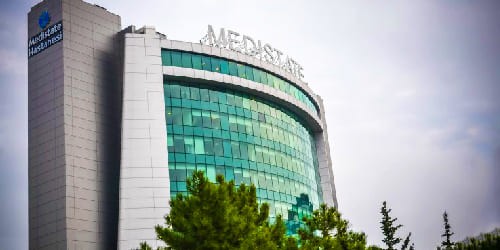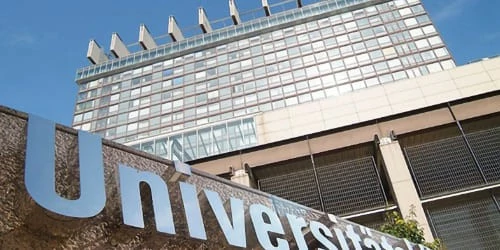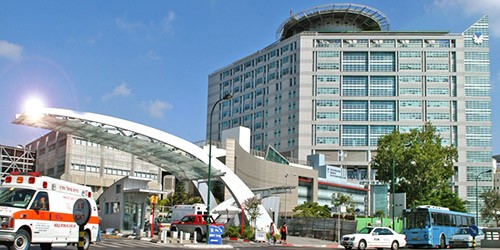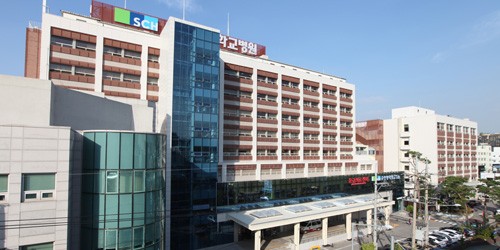Hairy cell leukaemia is a rare form of chronic blood cancer, accounting for 2% of all leukaemias. The disease is most common in men over the age of 50. A timely diagnosis and correct treatment can lead to many years of remission.
Read more about treatment for hairy cell leukaemia in this MediGlobus article.
Listen to the article:
What is hairy cell leukaemia and its symptoms?
Hairy cell leukaemia (HCL) is a malignant blood cancer. The bone marrow and spleen get damaged as a result of the abnormal formation of B-lymphocytes, which are a type of white blood cells. The course of the disease is slow, but it responds well to conservative treatment.
Hairy cell leukaemia is a chronic disease. This means that it cannot be cured completely. However, modern medicine can achieve long-term remission without affecting the quality and length of life.
In hairy cell leukaemia, the bone marrow produces too many immature B-lymphocytes. Their main function in the body is to fight infections, but the disease impairs this. Affected lymphocytes look “hairy” under a microscope, which gives the illness its name. As it progresses, the production of white and red blood cells as well as platelets slows down, affecting the whole body.

In some cases, the disease may be asymptomatic. It is sometimes discovered by chance during check-ups or when diagnosed in relation to other diseases. Most often, patients with hairy cell leukaemia have the following symptoms:
Fatigue and weakness, anaemia;
Feeling full after small meals;
Frequent infections and colds;
Sudden nosebleeds, gum sensitivity;
Easy bruising;
Sudden loss of weight.
Usually, at the time of diagnosis, the lesion reaches the bone marrow, spleen, liver and sometimes retroperitoneal lymph nodes.
Being diagnosed with hairy cell leukaemia increases the risk of developing second cancer, particularly bowel cancer, lung cancer or non-Hodgkin’s lymphoma; and autoimmune diseases.
The exact causes of hairy cell leukaemia are not fully understood. It is thought that certain industrial toxins and radioactive radiation may increase the risk of developing the disease. Doctors have found connections to the mutations in the BRAF gene, but it is not yet clear what role they play in the development of the disease.
In addition to ‘classical’ hairy cell leukaemia, there are two other less common subtypes: the HLC variant and the ‘Japanese’ variant. The former is more difficult to treat, while the latter is easier.

Make an appointment to see an oncologist
Foreign specialists will help you with the right diagnosis and treatment. To book a consultation, leave a request online by clicking on the button below. When available, oncologists can hold an online consultation.
Diagnosis of hairy cell leukaemia
When diagnosing hairy-cell leukaemia, the following tests are usually carried out:
Physical examination | One of the most common symptoms of hairy cell leukaemia that doctors can recognise is an enlarged spleen. It is observed in 80-90% of patients, but may not be present in the early stages of the disease. A computerised tomography (CT) scan of the abdominal organs may be prescribed for a more thorough examination. It may also detect enlarged retroperitoneal lymph nodes. |
Blood test | In the presence of hairy cell leukaemia, blood tests show reduced levels of all kinds of blood cells – red, white and thrombocytes. In some cases, however, the level of lymphocytes (white blood cells) may be normal or elevated. One of the main indicators of the disease is the presence of “hairy” cells in a peripheral blood smear. |
Immunophenotyping | A method of diagnosing leukaemia based on the analysis of antibodies to specific markers of cancer cells. |
Bone marrow biopsy | A bone marrow biopsy is the main way to confirm the diagnosis of hairy cell leukaemia and to rule out other diseases that can present in a similar way, such as marginal lymphoma of the spleen or B-cell prolymphocytic leukaemia. A bone marrow sample is taken from the thigh bone with a needle and tested for the presence of “hairy” lymphocytes. |
Examination of IL-2R levels in the blood | This test is rarely used; however, it can be useful for monitoring the progress of the disease and the effectiveness of treatment. |
Treatment of hairy cell leukaemia
Compared with other blood cancers, hairy cell leukaemia responds well to conservative treatment. In most cases, given the risks of the procedure, a bone marrow transplant is not necessary.
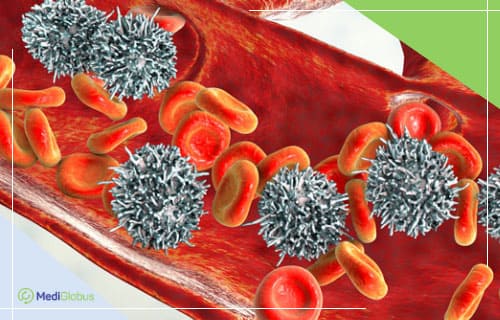
The main treatments for hairy cell leukaemia include chemotherapy, targeted therapy, drug therapy and maintenance therapy. In rare cases, the patient may need spleen removal.
Chemotherapy
The first-line treatment for hairy cell leukaemia is chemotherapy. Many patients see a positive effect from taking only one drug, while combination chemotherapy may be prescribed for relapses. In 85% of patients, treatment achieves long remission, although the risk of relapse remains. Over time, drug resistance may develop. In this case, doctors prescribe a different protocol or a targeted therapy.
The drugs need to be taken subcutaneously or intravenously for 2-6 months. Some patients may be fitted with a catheter, which will gradually push the medication into the bloodstream.
The most common side effects of chemotherapy for hairy cell leukaemia include tiredness, fever and an increased risk of infection.
Targeted therapy
Targeted therapy in the treatment of hairy cell leukaemia is used when chemotherapy is contraindicated due to poor drug tolerance, or to treat relapses. Monoclonal antibodies are used to treat this disease, capable of ‘recognising’ cancer cells in the body. In the treatment of relapsed hairy cell leukaemia, this protocol is effective in 80% of cases. In addition to these, the FDA has approved certain kinase inhibitors and BTK-blockers.
Medication therapy
Some patients with hairy cell leukaemia may be prescribed interferon. In about 65% of patients, the drug helps to stabilise the disease or induce a partial response. A course of treatment lasts about a year.
Supportive therapy
People with low red blood cell or platelet counts may need a blood transfusion. It is always irradiated to remove white blood cells and thus reduce the risk of graft-versus-host syndrome. Patients may also receive hormones that stimulate the production of blood cells. These methods can make the patient feel much better, but they do not cure the disease itself.
Surgery

Surgical removal of the spleen is carried out if it is severely enlarged and causes severe pain or discomfort to the patient. Emergency surgery is also carried out if the organ has ruptured. Most patients do not need surgical treatment.
Patients in remission with hairy cell leukaemia need regular check-ups after the end of treatment. They usually have an annual check-up with their doctor and undergo blood tests twice a year. Regular check-ups ensure that any changes in health status, including relapse, are detected in a timely manner. In between regular visits, patients should monitor their health carefully and report any viral or bacterial infections to their doctor.
CANCER TREATMENT BOOKING
Leave a request on our website by clicking on the button below and our coordinating doctors will help you to find a clinic for hairy cell leukaemia treatment and advise you on the individual cost of treatment. Our consultations are free of charge.
The prognosis for hairy cell leukaemia

85-95% of patients respond well to standard treatment for hairy cell leukaemia. Despite this, 40% of cases relapse within 2-10 years.
The speed of ‘recovery’ during treatment for hairy cell leukaemia depends on several factors:
Age and health of the patient;
The presence of any comorbidities;
The presence of any comorbidities;
At what stage has the leukaemia been diagnosed;
The aggressiveness of the disease;
The body’s response to chemotherapy.
With a good prognosis, patients can expect to live long and fulfilling life. People who manage to avoid a relapse in the first 2-5 years after diagnosis can expect to live as long as a normal person.
History of a patient with hairy cell leukaemia
Sarah-Jane Hayes, a UK resident, was diagnosed with hairy cell leukaemia at the age of 45. She initially went to doctors complaining of frequent infections and fatigue. Initial diagnosis revealed low blood counts and elevated D-dimer levels; as well as ferritin, calcium and vitamin D deficiencies.
“I was diagnosed with hairy cell leukaemia a long time ago. I spent about a year talking to different doctors until I finally had a bone marrow biopsy. When I heard my diagnosis, at first I was relieved that I finally knew exactly what was wrong with me! But after that, I had a panic attack. Luckily, I found an excellent haematologist, and my family has been invaluable in supporting me. I was able to leave my job and devote all my time and effort to treatment.
First, I underwent eight months of chemotherapy. I did relatively well – apart from constant fatigue and lethargy, I was not particularly affected by the side effects. I managed to achieve a partial remission. Unfortunately, it didn’t last long – within a few months I was back in the hospital, this time in a more serious condition.

I was prescribed medication again – this time, a three-month course of combined chemotherapy. It was a difficult ordeal, but fortunately, I managed to achieve complete remission.
I hope to get back to work eventually and have already started making plans for the future. Without the constant support of my family and friends, I would never have made it this far”.
Where to go for treatment for hairy cell leukaemia?
Resume
Hairy cell leukaemia is a malignant blood disorder in which too many immature ‘hairy’ B-lymphocytes form in the body. It is a chronic disease that cannot be cured completely but can go into remission for 10-20 years or more.
The main symptoms of hairy cell leukaemia include tiredness, susceptibility to infections, frequent bruising and bleeding, and an enlarged spleen. A laboratory blood test and bone marrow biopsy are carried out to diagnose hairy cell leukaemia.
Hairy cell leukaemia is treated successfully in 85-95% of cases with chemotherapeutic treatment protocols. Doctors may also prescribe targeted and drug therapy, and in rare cases – remove the spleen.
For treatment of hairy cell leukaemia abroad, you can go to clinics in Turkey, Germany, Israel, Spain and Korea. They offer high-quality service paired with state-of-the-art cancer treatment protocols. MediGlobus recommends the following clinics: Liv Ankara, Medistate, Navarra University Hospital, University Hospital of Cologne, Ichilov Medical Centre, and SoonChunHyang Hospital.
BOOKING FOR TREATMENT ABROAD
To make an appointment for hairy cell leukaemia treatment abroad, click on the button below and fill in the form. Our coordinators will call you back within 30 minutes. They will provide all the necessary information and help with travel arrangements.
Sources:
- 1. The New England Journal of Medicine: BRAF Mutations in Hairy-Cell Leukemia
- 2. Hairy Cell Leukemia Foundation
- 3. American Oncology Association





